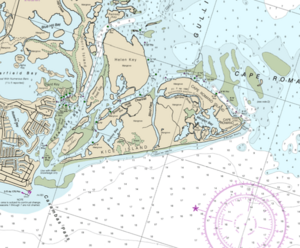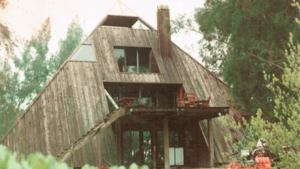Cape Romano facts for kids
Cape Romano is a special point of land, or a cape, located on the Gulf Coast of Florida, in the United States. It sits on Cape Romano Island, which is part of a larger group of islands called Kice-Morgan Island.
Contents
How Cape Romano Got Its Name
The famous writer Marjory Stoneman Douglas believed that Cape Romano was named after Bernard Romans. He was a mapmaker who drew detailed maps of Florida's coasts way back in 1774. On his maps from 1774, the cape was called "Cape Roman or Punta Larga."
Later, in 1837, another person named John Lee Williams wrote about the area. He called the southern tip of "Isle Roman" by the name "Cape Roman," which was used on British maps. Spanish maps, however, had different names for it, like "Puerta Longa," "Punta Longa," and "Cape Acies."
Exploring Kice-Morgan Island
Kice-Morgan Island is found just south of Marco Island in Collier County. Caxambas Bay separates it from Marco Island. In 1837, John Lee Williams described the island south of Caxambas Bay as "Isle Roman." He said it was about 15 miles (24 km) long and 10 to 12 miles (16 to 19 km) wide.
This island area is made up of narrow barrier beaches. Behind these beaches are large mangrove forests, which are special trees that grow in salty water. In 1976, the Kice Island beach was about 2.5 miles (4 km) long. It stretched southwest from Caxambas Pass and Bay.
Hurricane Wilma's Impact
In 2005, Hurricane Wilma hit the area near Cape Romano. The storm brought a huge 10-foot (3 m) storm surge onto Kice Island. This powerful storm created a new opening in the middle of the island, which is now called Morgan Pass. Because of this, the southern part of Kice Island is now known as Morgan Island.
In the ten years after Hurricane Wilma, much of the beach on Morgan Island washed away. Some of the sand from Kice-Morgan beaches moved south. This sand formed a new sand spit at the very southern end of Morgan Island. Other sand moved even further south onto the Cape Romano shoals, which are shallow areas of sand under the water. As of 2023, maps show Cape Romano on Cape Romano Island, which is behind the Morgan Island beach. The sand spit at the southern end of Morgan Island now reaches even further south than Cape Romano Island itself.
People of Cape Romano
The town of Muspa, which was part of the Calusa Native American group, might have been located on or near Cape Romano. One old Spanish map even called the cape "Punta de Muspa." Descriptions of where the town was located also seem to fit the cape's position.
In 1837, John Lee Williams mentioned farms near Caxambas Bay. This made historian Charlton W. Tebeau think there might have been a farm at Cape Romano. In 1838, a military group camped on Cape Romano. They found fresh water at the site of an old settlement. The cape was later known for having a reliable fresh water well, which local people used.
The Hermit and the Dome House
A man named Joe Dickman lived on Cape Romano as a hermit from the 1930s until the 1960s. He lived a quiet life by himself.
Later, in the 1970s and 1980s, several houses were built on or near Cape Romano. However, the beach slowly eroded away, leaving these houses standing in the open water. Hurricanes have also washed them away over time. One famous example is the Cape Romano Dome House, which was a unique pyramid-shaped house.
See also
 In Spanish: Cabo Romano para niños
In Spanish: Cabo Romano para niños



